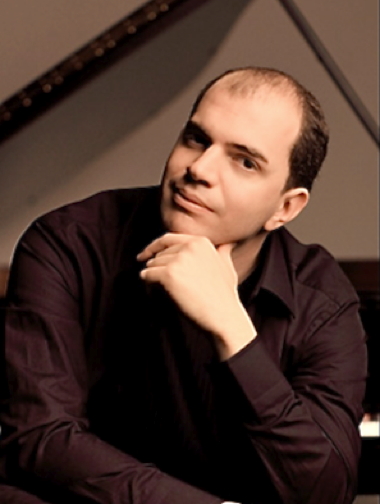Kirill Gerstein’s invitation to the dance makes for a memorable afternoon

With a cancellation by the originally scheduled Maurizio Pollini — and it being Mother’s Day — it was hardly a surprise that there were so many empty seats for replacement Kirill Gerstein’s Sunday afternoon appearance at Symphony Center. That was unfortunate for the Russian-born pianist delivered a surprisingly memorable recital.
Gerstein, who at fourteen was the youngest student ever accepted into the Berklee College of Music, showed considerable promise as a jazz pianist but opted instead to concentrate on a classical career. It is obvious from both his repertoire choices and his performance approach that Gerstein still effectively straddles both worlds.
A two-time Gilmore Award winner — in 2002 a recipient of the Young Artist Award and in 2010 a recipient of its $300,000 Artist Award — Gerstein used some of his prize money to commission a piano piece from pianist/composer Brad Mehidau in a jazz style that would allow for layers of complexity that improvisation alone would not permit.
The result, a 25-minute piece called Variations on a Melancholy Theme, was premiered at Berklee in late March and was performed on the first part of Gerstein’s program.
As is true of the great examples of the form such as Bach’s Goldberg and Beethoven’s Diabelli variations, the real attraction is not the theme itself — usually borrowed, but in this case devised by Mehldau — but the imaginative transformations of the theme. Here there are fourteen variations and a coda.
The theme itself extends widely outward before turning back on itself which allows for a greater variety of harmonization and styles than it does for melodic permutations. There is little opportunity for modulation and the piece’s jagged and often ethereal approach to rhythm sounds more rooted in Scriabin than American jazz.
The overall effect comes across more like young Keith Jarrett or Chick Corea solo improvisations on steroids rather than a piece actually written down. And yet, the dynamic nuance and delicate touch that Gerstein exhibited with this work — even in its most expansive octave-imbued sections — owe more to the classical world than the jazz world.
The rest of the program consisted of works that spotlighted dance, especially the waltz. Gerstein’s take on Weber’s Invitation to the Dance was given one of the most delightful performances imaginable, and Liszt’s Valse caprice No. 6 from Soireés de Vienna (after Schubert) exuded carefree Viennese charm.
The gigue was the centerpiece with a mix of Busoni’s Giga, Bolero, e Variazione, a pianistic romp through Mozart’s Eine kleine Gigue, K. 574 and the fandango from Act III of The Marriage of Figaro. The dance form was also spotlighted in Bach’s English Suite No. 6 ,BWV 811, which opened the program.
The freedom that was displayed across the entire program was remarkable, no doubt a byproduct of Gerstein’s interest in jazz. The Bach particularly not only had a swing quality to it but the phrases breathed with an extraordinary sense of improvised inevitability. And yet, every line was clear.
Schumann’s Carnaval crowned the program. Rarely will one hear such such a perfect balance of humor and poignancy, with Gerstein colorfully bringing out numerous small details while never losing sight of the whole.
Clearly this is a pianist not only with extraordinary technique and musicianship but with that rarest of gifts, a delicate touch that can transform timbre. He also displays a compelling musical intellect with rarely a shortage of interesting ideas to communicate and a refreshing performance style placed at the service of the music rather than his own self-aggrandizing.
Gerstein’s encore — Earl Wild’s Virtuoso Etude No. 6 on Gershwin’s I Got Rhythm — seemed perfectly suited to bridge the two worlds he inhabits, cross-fertilizing classical virtuosity with the apparent freedom of jazz. Gerstein’s delightful fluctuations and nuances called to mind Gershwin’s own lively performing style.
Posted in Performances




